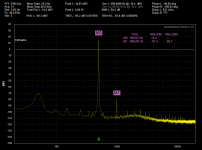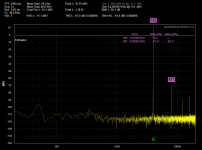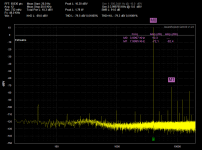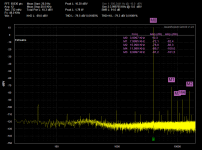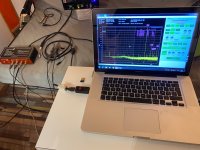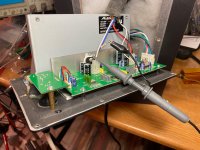Hi,
Before I reassembled those powered speakers after repairing one of them, I tried some so simple mod
to improve THD of each amp section.
This can be applied to a lot of amps, when they cheap out a bit on capacitors in the power section…
To prove my point, I ‘ll run a similar mod and video on a Rotel 840 BX II, which doesn’t have the capacitors mentioned on
the schematic ! Increasing many times the original capacitance feeding the power section, is needed to obtain a meaningful
THD improvement 😊, here between -8 dB and almost -20dB on the best of the two power sections…
I cheaped out myself putting only 470uF on some of the two channels, depending on which one it was…the better one or the regular one, to give them a name 😉.
I certainly could have pushed somewhat further than the -80 dB THD figure , I obtained overall, but felt that was ok for these amps 😉!
Before I reassembled those powered speakers after repairing one of them, I tried some so simple mod
to improve THD of each amp section.
This can be applied to a lot of amps, when they cheap out a bit on capacitors in the power section…
To prove my point, I ‘ll run a similar mod and video on a Rotel 840 BX II, which doesn’t have the capacitors mentioned on
the schematic ! Increasing many times the original capacitance feeding the power section, is needed to obtain a meaningful
THD improvement 😊, here between -8 dB and almost -20dB on the best of the two power sections…
I cheaped out myself putting only 470uF on some of the two channels, depending on which one it was…the better one or the regular one, to give them a name 😉.
I certainly could have pushed somewhat further than the -80 dB THD figure , I obtained overall, but felt that was ok for these amps 😉!
That's quite an improvement! Do you have a PDF you can post so we can see better what you changed?
I've always thought that powered monitors could be greatly improved.
I've always thought that powered monitors could be greatly improved.
Hi Arthur,
Thank you for watching ,
Here it is, (you can find it on the web very easily though 😊).
don’t forget to like if you did 😊,
and subscribe it will eventually lead to more visibility for others too 😊!
Best,
Eric
PS:
- you need 8 x 1000uF/50volts caps C5/C4 and C31/C34 for the two speakers (4 caps per channel), it will be tight fit but it can be done 😉.
- Don’t forget not to try to put a scope on the output if it’s grounded , the spectrum analyser I used was isolated from ground , due to the architecture of the bi-amps.
To complete my post some of the answers I made on another forum ,it gives some more insight 😉
**************************************************************************************************************************
So , the power levels first , I use self made probes for the QA 400 unit , that have selectable -20dB or -40dB attenuations, replacing the more modern analyser versions which have built in attenuators in the unit 😅.
I used the -20dB setting , ie power readings should be increased by 20 dB , thanks for pointing that out !
This is the subject that most likely needs lot more work 😎.
The Video stemmed from an idea, on the simplest of mods to somewhat improve THD, and I ran some tests as quickly as possible to get to see if I could get results and what they were🥸.
My real thought, was about the Rotel 840 BX4 , where I had THD and power readings… although not complete, but much more than on the Alesis which was an afterthought , that my thinking could be extended to it 😊.
So on power :
First according to schematic they are two different amp sections:
High frequency : LM2876T feeding into
25 watts according to manual 4 ohm load ?
Low frequency : LM 3886T feeding into
75 watts according to manual 6 ohm load ?
I haven’t checked any of this load values, but my loads were 8 ohms!
quite far away from the supposed values….I did not read parts specs,
my bad , as I wanted to complete this little teaser video in an hour!
(It took me three / four times as much at least !)
So firstly, I will have to get 6 ohm load (or maybe three times 2), to run some further tests ! Or use the speakers 🙃
Also, I should, if I was to be complete, check the actual speakers impedance over frequency …
although I probably won’t have time for that…ie I ll rather spend time to devise a method for comparing almost accurately 😉, their near field frequency response compared to my much better Focal Solo 6 and see if I can devise that way, a simple trick, to make them much closer to true flat response ie much similar to the one I get by ear from Solo6 versus M1…
(To make those Alesis useable for me, or if not sell them 😊.)
According to Manual
LOW FREQUENCY AMPLIFIER
Rated power output: 75 watts, 6Ω load
Distortion: <0.02% / (= -73.9 dB) THD @ 30 watts/8Ω 20Hz-20kHz
Slew rate: 19V/µsec
Signal-to-Noise ratio: >110dB referenced to 60 watts @ 8Ω,
1kHz
HIGH FREQUENCY AMPLIFIER
Rated Power Output: 25 watts, 4Ω load
Distortion: 0.025% / (= -72.041 dB) THD @ rated power
Slew rate: 9V/µsec
Signal-to-Noise ratio: >112dB @ rated output
What I did : I had set my input level to -10 dB, level pot at max level … why ? I did not run precise power measurement , I checked if it warmed up the dummy load 😅 and did not start decreasing THD too much , it’s was a super quick hands on empirical approach 😂.ie not precise !
If I get the time , I’ll take appart again one of the units and will run a new sets of more serious power measurements (and THD)😉.
I did informal testing before doing the video, and I know how these sound ,this how I chose the test frequencies…
Meaning, I felt 1khz would not approximate truly THD response of the low end , one could discuss even not going lower…
They say in the manual tweeter response is flat to 2k ! , so 1k is not useful to my hear to run some tests on the low end…this is practice of the field rather than standard testing…
(I consider those drivers and we’re in my mind the most energy is, ie much lower than 1khz)
I confirm not watching too closely some of the calculations reported by QA, and using my own THD approximation ,
because QA is old and somewhat buggy, in some of it’s calculations on screen, I won’t go into all details, but having long software debugging experience, I seem to always step right in were all the bugs and forget fullness are 🙃😉, so it takes me more time to figure if what it is displaying is accurate or not than measuring myself between fundamental and harmonics to get a very precise* idea of where THD lies, (*given the whole picture and the other harmonics..I am not the only one running such approximation on field measurements 😊.)
I ran few times before in loop back my own calculations and confirmed It to be better and quicker off this way…this is a low cost OLD Spectrum analyser, so you, as always, have to know your instrument 😉.
Your right on the depth and averaging, but my tries (loop back) , gave me confidence and ease (speed) of use with these setting…64k is slow…
I reset often the averaging, and get a quick feel, what’s seems to be going on 😊.
The power displayed figures are all wrong any how, as the setting of the QA 400 was for 8 ohms load, not accounting for the reality of those amps expectation 😉, 6 and 4 ohms, so in the end I was right on the money to avoid the watts output issue all together in this first try 😅.
My whole interest is to push the envelope as quickly and easely as possible using gear lying around and trying to innovate a bit with it 😊.
Eric
Spark excellence and innovate
Thank you for watching ,
Here it is, (you can find it on the web very easily though 😊).
don’t forget to like if you did 😊,
and subscribe it will eventually lead to more visibility for others too 😊!
Best,
Eric
PS:
- you need 8 x 1000uF/50volts caps C5/C4 and C31/C34 for the two speakers (4 caps per channel), it will be tight fit but it can be done 😉.
- Don’t forget not to try to put a scope on the output if it’s grounded , the spectrum analyser I used was isolated from ground , due to the architecture of the bi-amps.
To complete my post some of the answers I made on another forum ,it gives some more insight 😉
**************************************************************************************************************************
So , the power levels first , I use self made probes for the QA 400 unit , that have selectable -20dB or -40dB attenuations, replacing the more modern analyser versions which have built in attenuators in the unit 😅.
I used the -20dB setting , ie power readings should be increased by 20 dB , thanks for pointing that out !
This is the subject that most likely needs lot more work 😎.
The Video stemmed from an idea, on the simplest of mods to somewhat improve THD, and I ran some tests as quickly as possible to get to see if I could get results and what they were🥸.
My real thought, was about the Rotel 840 BX4 , where I had THD and power readings… although not complete, but much more than on the Alesis which was an afterthought , that my thinking could be extended to it 😊.
So on power :
First according to schematic they are two different amp sections:
High frequency : LM2876T feeding into
25 watts according to manual 4 ohm load ?
Low frequency : LM 3886T feeding into
75 watts according to manual 6 ohm load ?
I haven’t checked any of this load values, but my loads were 8 ohms!
quite far away from the supposed values….I did not read parts specs,
my bad , as I wanted to complete this little teaser video in an hour!
(It took me three / four times as much at least !)
So firstly, I will have to get 6 ohm load (or maybe three times 2), to run some further tests ! Or use the speakers 🙃
Also, I should, if I was to be complete, check the actual speakers impedance over frequency …
although I probably won’t have time for that…ie I ll rather spend time to devise a method for comparing almost accurately 😉, their near field frequency response compared to my much better Focal Solo 6 and see if I can devise that way, a simple trick, to make them much closer to true flat response ie much similar to the one I get by ear from Solo6 versus M1…
(To make those Alesis useable for me, or if not sell them 😊.)
According to Manual
LOW FREQUENCY AMPLIFIER
Rated power output: 75 watts, 6Ω load
Distortion: <0.02% / (= -73.9 dB) THD @ 30 watts/8Ω 20Hz-20kHz
Slew rate: 19V/µsec
Signal-to-Noise ratio: >110dB referenced to 60 watts @ 8Ω,
1kHz
HIGH FREQUENCY AMPLIFIER
Rated Power Output: 25 watts, 4Ω load
Distortion: 0.025% / (= -72.041 dB) THD @ rated power
Slew rate: 9V/µsec
Signal-to-Noise ratio: >112dB @ rated output
What I did : I had set my input level to -10 dB, level pot at max level … why ? I did not run precise power measurement , I checked if it warmed up the dummy load 😅 and did not start decreasing THD too much , it’s was a super quick hands on empirical approach 😂.ie not precise !
If I get the time , I’ll take appart again one of the units and will run a new sets of more serious power measurements (and THD)😉.
I did informal testing before doing the video, and I know how these sound ,this how I chose the test frequencies…
Meaning, I felt 1khz would not approximate truly THD response of the low end , one could discuss even not going lower…
They say in the manual tweeter response is flat to 2k ! , so 1k is not useful to my hear to run some tests on the low end…this is practice of the field rather than standard testing…
(I consider those drivers and we’re in my mind the most energy is, ie much lower than 1khz)
I confirm not watching too closely some of the calculations reported by QA, and using my own THD approximation ,
because QA is old and somewhat buggy, in some of it’s calculations on screen, I won’t go into all details, but having long software debugging experience, I seem to always step right in were all the bugs and forget fullness are 🙃😉, so it takes me more time to figure if what it is displaying is accurate or not than measuring myself between fundamental and harmonics to get a very precise* idea of where THD lies, (*given the whole picture and the other harmonics..I am not the only one running such approximation on field measurements 😊.)
I ran few times before in loop back my own calculations and confirmed It to be better and quicker off this way…this is a low cost OLD Spectrum analyser, so you, as always, have to know your instrument 😉.
Your right on the depth and averaging, but my tries (loop back) , gave me confidence and ease (speed) of use with these setting…64k is slow…
I reset often the averaging, and get a quick feel, what’s seems to be going on 😊.
The power displayed figures are all wrong any how, as the setting of the QA 400 was for 8 ohms load, not accounting for the reality of those amps expectation 😉, 6 and 4 ohms, so in the end I was right on the money to avoid the watts output issue all together in this first try 😅.
My whole interest is to push the envelope as quickly and easely as possible using gear lying around and trying to innovate a bit with it 😊.
Eric
Spark excellence and innovate
Attachments
So here is the conclusion 😊!
I devised a simple way without new dummy load resistors 😂 see photo , I piggy backed the speakers…
Results are for the best of the two units (that is the one I re-opened)
With 4,64 watts on the low channel (this is what I was running all along but now with proper ohm input in software , still -10 db in, full volume pot 😉), you can read -95,7 dB THD +N !
On the high channel I was running less than a watt with -10db in , so I raised to 1,78 watts and no impact on THD…you can still read -82,2 THD+N
To make everybody happy I ran a slow 64k ….you can read yourself still -82,4 THD+ N ,
( and I assume that the 6 db lower next closest spur before the rest being -20 dB down don’t really affect the proper calculation… by -3 dB like the -79,3 dB screen figures wants you to believe 🙃)
We started around -72 db THD+N, Conclusion : the recipe works ! 😎
Eric
PS: one thing I mentioned in the video, but forgot to show was the setup with floating ground the gizmo on the USB port..here is the photo.
I devised a simple way without new dummy load resistors 😂 see photo , I piggy backed the speakers…
Results are for the best of the two units (that is the one I re-opened)
With 4,64 watts on the low channel (this is what I was running all along but now with proper ohm input in software , still -10 db in, full volume pot 😉), you can read -95,7 dB THD +N !
On the high channel I was running less than a watt with -10db in , so I raised to 1,78 watts and no impact on THD…you can still read -82,2 THD+N
To make everybody happy I ran a slow 64k ….you can read yourself still -82,4 THD+ N ,
( and I assume that the 6 db lower next closest spur before the rest being -20 dB down don’t really affect the proper calculation… by -3 dB like the -79,3 dB screen figures wants you to believe 🙃)
We started around -72 db THD+N, Conclusion : the recipe works ! 😎
Eric
PS: one thing I mentioned in the video, but forgot to show was the setup with floating ground the gizmo on the USB port..here is the photo.
